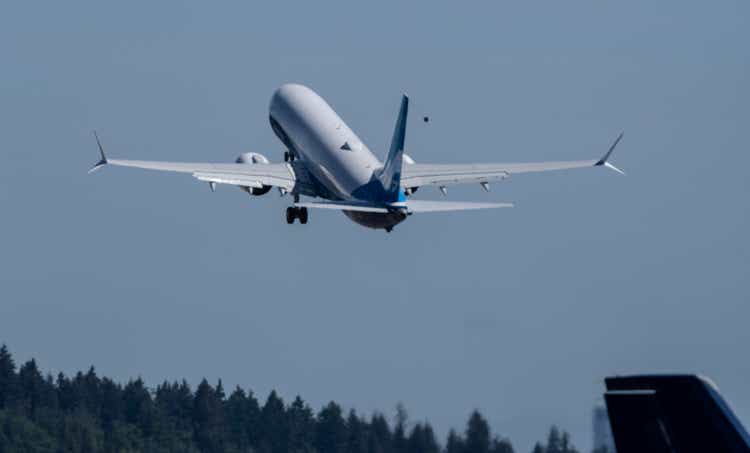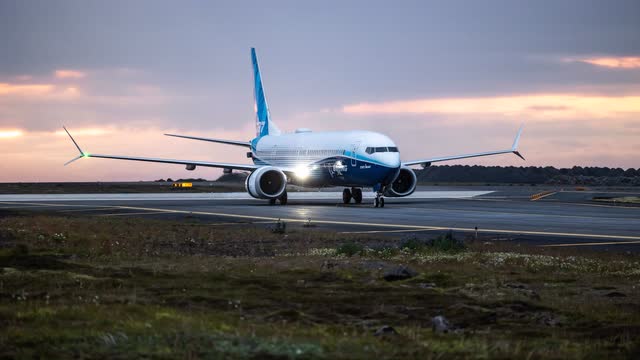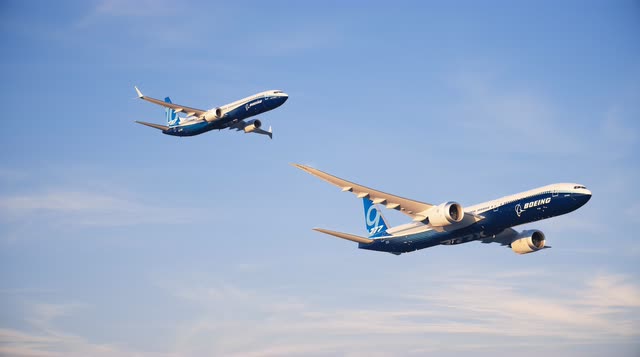Stephen Brashear
In a recent interview with Aviation Week, The Boeing Company (NYSE:BA) David Calhoun called the Boeing 737 MAX 10 an all or nothing project and said that a world could do without the MAX 10, the biggest variant of the Boeing 737 MAX family. Putting it altogether, Calhoun is willing to abandon the Boeing 737 MAX 10 or at least it seems like that. In this report, I discuss why Calhoun’s comment barely comes as a surprise.
Boeing 737 MAX 10 in Jeopardy
Boeing 737 MAX 10 in Iceland (Boeing)
There are many points where we can start the discussion, but a proper point to start would be the Aircraft Certification Reform and Accountability Act passed by Congress in 2020. Among other elements, the reform act includes requirements on flight crew alerting systems, which are believed to increase situational awareness on the flight deck. Something that should prevent crashes, like the ones with the Boeing 737 MAX, to ensure they never occur again.
For those interested, the section regarding the flight crew alerting system is pasted below:
SEC. 17. FLIGHT CREW ALERTING.
(a) In General.-Not later than 1 year after the date of enactment of this Act, the Administrator shall fully implement National Transportation Safety Board recommendations A-19-11 and A-19-12 (as contained in the safety recommendation report adopted on September 9, 2019).
(b) Prohibition.-Beginning on the date that is 2 years after the date of enactment of this Act, the Administrator may not issue a type certificate for a transport-category aircraft unless-
(1) in the case of a transport airplane, such airplane incorporates a flight crew alerting system that, at a minimum, displays and differentiates among warnings, cautions, and advisories, and includes functions to assist the flight crew in prioritizing corrective actions and responding to systems failures; or
(2) in the case of a transport-category aircraft other than a transport airplane, the type certificate applicant provides a means acceptable to the Administrator to assist the flight crew in prioritizing corrective actions and responding to systems failures (including by cockpit or flight manual procedures).
When this Act was passed by Congress in late 2020, it was widely assumed that the Boeing 737 MAX 10 certification process would be completed within the two years grace period that the Act encapsulates. However, in February 2021 Boeing delayed the service entry to 2023 which made it unlikely that certification was expected to be completed within the two-years window that the Act provided. That means that absent of a waiver or a flight crew alerting system, the Boeing 737 MAX 10 could not be certified.
So, Boeing has two routes it can take. The first one is to implement a form of a flight crew alerting system to make it compliant with the newest regulations. However, such measure would cause the Boeing 737 MAX to be significantly different than other 737 MAX models and predecessors. One could wonder whether from safety perspective it would make sense to make it a required item only on the Boeing 737 MAX 10. In fact, requiring it on one model and not on others could itself become a safety hazard.
The other option Boeing has is to seek a waiver for the Boeing 737 MAX 10, which it has been doing. Obviously, this can be met with some skepticism from critics, but there are good reasons to seek a waiver besides the financial and timeline risks.
Gathering Airline Support For The MAX 10
Now, the big problem is that seeking a waiver can be met with fierce resistance from politicians in Washington and I wouldn’t blame them as they are ultimately tasked with safeguarding the consumers or citizens and given the major problems Boeing faced finding support for things that make sense or could normally easily count on political support is not self-evident. Calhoun’s threat to abandon the MAX development is unexpected to say the least. It fits in pattern of Boeing seeking support for the MAX 10 for a while now.
In March, Alaska Airlines (ALK) backed the Boeing 737 MAX 10 at the expense of the Boeing 737 MAX 9. The announcement made Alaska Airlines the second carrier that sees a role for the Boeing 737 MAX 10 in its fleet after United Airlines. United Airlines has been a long time supporter of the MAX 10 and amplified that support with an order for 50 Boeing 737 MAX 8s and 150 Boeing 737 MAX 10 last year. In April this year, I already published a report saying that Delta Air Lines might order the MAX 10 and back then I already pointed out that Boeing was gaining support for the MAX 10 among its customers to generate leverage and get a waiver for the MAX 10 in place. We are currently seeing a lot of rumors about a potential MAX 10 order from Delta Air Lines on the Farnborough Airshow. That development, however, is not completely new. Delta Air Lines is one of the airlines I have tipped as a potential customer for the MAX and more recently for the MAX 10 for quite some time now.
So, what we see is that Boeing has carefully orchestrated support for the MAX 10 among its US customers for a while now. All combined, this could be over 400 MAX 10 aircraft for the US market. So, Boeing can make a strong case that not providing a waiver will affect the operations of the US airlines even more so since Airbus cannot produce its jets fast enough either and from there you can make the quick jump to not granting a waiver will ultimately be at a disadvantage for the US economy, Boeing’s competitive strength and what Boeing likely will want to emphasize more these days is the disadvantage for the US traveler which would see a cost efficient fleet solution being eliminated which will not provide the unit cost reductions that airlines are looking for and thereby increase costs and possibly fares.
Gathering Political Support For The MAX 10
In April, during the first quarter earnings call, David Calhoun was asked the following question:
And if the MAX 10 slips beyond year-end and then you need the new flight crew alerting system, do you assume you’ll get the waiver, or does this put the program at risk? I mean, if you can’t get the 10 done without substantial more cost and looking at the order book, do you just leave that market for next airplane?
He provided the following response:
It’s a great question. I hope I never get there. First and foremost, with respect to the original legislation, there was a lengthy window put in there based on historic certification timetables that would have provided for the seven and 10 easily.
So these things have taken longer. The intent of that legislation was never to stop the derivative product line with respect to the MAX. So I believe our chances are good with respect to getting legislative relief. It doesn’t mean we’ll get them. And if we don’t, it’s a problem.
His response spoke volumes or well the lack of presenting a solution and leaving things open-ended in case a waiver is not obtained. It was part of the campaign that Boeing has to get a waiver for the MAX 10 approved. Signaling that there is another easy solution, most certainly wouldn’t help Boeing’s case and with strong support from US airlines and the rumors about a MAX 10 order from Delta Air Lines already surfacing at the time, Calhoun was in the position to leave the fate of the Boeing 737 MAX 10 open ended putting the consequences of not getting a waiver in the hands of politicians.
Calhoun’s response followed a March note from the FAA that the MAX 10 was unlikely to be certified by year-end and the sponsor of the reform act not being in favor of a waiver for the MAX 10 while Maria Cantwell, the chairwoman of the Commerce, Science and Transportation committee, seemed to be more willing to grant a waiver.
Calhoun Brings Out The Big Guns
Boeing 737 MAX 10 and Boeing 777-9 (Boeing)
There, however, was no breakthrough and it forced Calhoun to bring out the big guns threatening to abandon the MAX 10 development. Even his comments about the Air Force One program development in some way can be connected to this campaign to get a waiver in place. So, Calhoun in an interview briefly before the Farnborough International Airshow threatened to walk away from the MAX 10. To provide that last bit of pressure in the campaign. Spicy detail: Boeing has sent its Boeing 737 MAX 10 to the Farnborough Airshow for public display. It seems like the last bit of pressure that Boeing can put on Congress and things have also been timed to generate maximum leverage and exposure for their case.
A World Without The MAX 10 Is A Problem For Boeing
During the interview, Calhoun suggested that Boeing could do without the MAX 10. That is to downplay the financial importance for Boeing as the financials at Boeing landed the company in an awful decision making process that contributed to the MAX crashes. The reality is that not developing the MAX 10 will be a huge problem for Boeing. Competitor Airbus has outsold the biggest variant of the Boeing 737 Next Generation by a wide margin and also the MAX 9 did not do a good job at all to close that gap. With the MAX 10, Boeing is able to win some orders that it would otherwise have to hand to Airbus. That also means that in case the MAX 10 does not receive a waiver, Boeing could see some of the MAX 10 orders being converted to the MAX 9 but overall it would likely fall behind further in the competition with Airbus for large single aisle aircraft orders. That is the reality even though Calhoun suggested otherwise downplaying the effect of not getting a waiver in place.
Conclusion
Calhoun’s words and timing are part of a campaign where a waiver for the Boeing 737 MAX 10 is at stake. Boeing has been generating a customer base in the US for the MAX 10 strengthen its case, but it hasn’t been able to force a breakthrough. Even Calhoun’s comments during the first quarter earnings call did not impress Congress and so days before the start of the Farnborough International Airshow Calhoun has threatened to walk away from the MAX 10. Such a move would hurt Boeing’s sales prospects for the foreseeable future, but it also gives Boeing the opportunity to put the consequences for airlines and US travelers as the responsibility of those in Congress that are opposing a waiver for the MAX 10. A Delta Air Lines order will be the next element for Boeing to increase pressure on Congress. While Boeing has chosen the wrong path with disaster as a result, I do think there are good reasons grant a waiver for the MAX 10 and those reasons are more important than sticking to political principles as a new set of enhancements being required on the MAX 10 but not on other aircraft potentially creates a new safety risk.


Be the first to comment